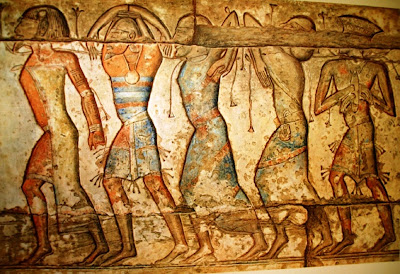The "Power" of the Priestly Blessing - Torah portion Naso
 |
| Ketef Hinnom "Priestly Blessing" amulet, c. 600 BCE |
It's also significant that the blessing was used as an amulet, and that it was found in a burial chamber. Biblical scholar Baruch Levine writes about this in his commentary on Numbers:
It was a widespread ancient custom to bury valuable or useful possessions with the dead, on the notion that the deceased would require them or enjoy them in the afterlife, as biblical concepts would have it, in Sheol. The precise text of the benediction inscribed on the amulets, if we may call the plaques by that name, might indicate further that the benediction was interpreted as being particularly relevant to the dead, as expressing the wish that the dead be protected in death and on their way to Sheol. There was also the wish that the Deity would deal benevolently with the dead in the netherworld. (Anchor Yale Bible, Numbers Vol. I, p. 242.)Levine continues that the words "yishmor" and "shalom" both represent the desire for safety when traveling or facing the unknown, and that in fact Midrashic sources on the Priestly Blessing offer the interpretation of shalom as referring to the afterlife:
Shalom is of great importance, for even the dead require shalom... "May he protect you" - May he protect your nefesh at the time of death; may he protect your footsteps from Gehinnom. (Sifre, Naso)
"May he protect you" - for the world to come. (Yalqut Shimoni, Naso)As Levine noted, the amulet was one of a number of possessions buried with a person, meaning it was most likely not made for the express purpose of use with the dead. Rather, it was an amulet used by the living, something people would keep on their person for apotropaic purposes, i.e. to ward off evil.
Was the original purpose of the blessing apotropaic? This goes to the question of how the Torah regards the efficacy of magic, incantations, blessings and curses. Did it view these things as having real "power"? (Perhaps it's something like the question of whether the Torah, when it mentions "other gods," is coming from purely a monotheistic perspective, or perhaps it is expressing something of a monolotrous point of view.) But regardless of how the Torah itself regards magic, it is certain that a popular belief in magic existed in Biblical times, and indeed persists to this day, including among religious Jews. This is where we encounter the difference between "rationalist" and "mystical" perspectives.
For instance, what "happens" when a kohen recites the Priestly Blessing? Does this "cause" a bounty of goodness to rain upon the receivers? Does it act as a God-sanctioned "incantation" for protection and peace? Many would view it that way. In fact a number of years back I spoke with a kabbalist who claimed that it was the Ashkenazic tradition of not reciting the daily Priestly Blessing in the diaspora which allowed the Holocaust in Europe to occur. The "shield of protection" was lifted.
According to the rationalist approach, the recitation of the Priestly Blessing does not itself "do" anything. No "levers" are pulled in the heavenly realm. Instead, it communicates the desire for well-being and peace. It is closer to a prayer. And I believe that in this approach lies no less great of a "power."
When we sincerely wish for the shalom of others, not only does it arouse and reinforce our own feelings of compassion, it means they - our friends and neighbors - don't have to feel alone. We're in this world together, facing challenges together, being there and rooting for one another's success. That sense of being part of team, of knowing there is love and support around us - that, I believe is the true "power" of the Priestly Blessing, among other wishes for one another's well-being. Not that the words themselves "do" anything for us, nor even that it "convinces" God to do anything for us. Rather, it is an expression, and perhaps a fulfillment, of the commandment to "love your neighbor as yourself."



Comments
Post a Comment
Not sure how to leave a comment? By "Comment as", either choose your Google ID, OR select "Name/URL". Type your name and leave URL blank (if you don't have a web address). Then hit "Publish", type in the letters/number shown, and again "Publish". I don't mind anonymous comments, but please use a pseudonym.